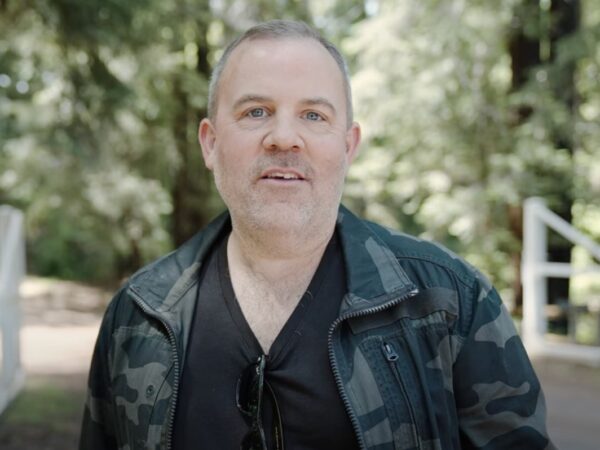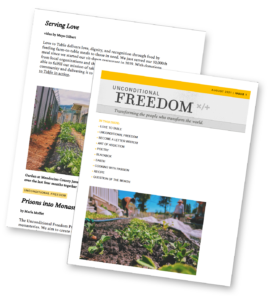by Bob Wilms
Bob is the Co-Director of the Prison Monastery Program and The Director of the Earth Program on the Land where he resides in Northern California.
I can’t remember where this actually began.
My body would start shaking uncontrollably. I couldn’t sleep. I wanted to crawl out of my skin. I was in a hotel room in Santa Barbara with my family when I was 16 or 17. I had been staring at the ceiling for an hour, and couldn’t take the sterile environment of the mass-produced furniture in the room any longer.
I walked out to the beach in the middle of the night, closed my eyes and sat and listened to the ocean, close enough to hear the final hissing gasp of the wave as it crept up onto the beach and receded back into the abyss.
There was another time, I was at a ten-day, silent Vipassana meditation retreat, and at the very end of the night — my first formal foray into meditation — I was restless and couldn’t sleep. I laid down on the cool, hard granite rock surface near Yosemite, and looked at the stars and listened. My North Face jacket rustled in the silence. I heard some movement from the trees above, and before I knew it, I felt a woosh in the air above me as the silhouette of a four-foot wingspan creature buzzed a foot or so from my body, jettisoned back into the forest.
It was around this time that I (re)discovered nature. I would jog into the mountains and would stop and listen. I could hear a rustling up the hillside as a squirrel climbed through the bushes. Off in the distance a couple of birds chirping in call and response. How many birds did I hear, from what direction? The sound of the wind blowing through the treetops?
When the forester stopped along the trail in the middle of the redwoods and let out, “HOOT… HOOT…. HOOT,” something lit up inside me. Something awakened. Chills ran up my back.
Adam and I had been walking up and down the forest looking at maps and talking about acreage and technical details of a forestry restoration grant. A fairly dry and heady conversation. There’s something about the sound of his voice that grabbed my body and shook it from the inside. It was primal.
I like to do that too. I just nodded, and listened to his instructions for doing the spotted owl call. (You have to check for spotted owls in the area before you start using power tools. You don’t want to light up your chainsaw when two owls are mid coitus during breeding season. It’s a federal offense.)
I didn’t want to immediately disclose that I do bird calls for fun. To connect myself back into this wheel of life that we call nature.
I go on hikes, sometimes completely out of my mind, depressed, angry, whatever, and I listen and I talk to the birds. I try to sound just like them. Occasionally, but seldomly, I’ll pull out my birdsong app just to learn what kinds of birds are making these beautiful songs.
I rarely let people see this side of me, but this is like jazz to me. The unhinged sound of Charlie Parker improvising through the changes of Donna Lee, or the interplay between Miles, Coltrane, Adderley, and Bill Evans.
I’m often scoping out the terrain and thinking about what needs to be done, where I need to thin out the undergrowth or clear out some dead wood, but this is the moment that I create something sacred, something special. This is where I connect back to the whole.
“We are called to be there. When we can listen to what the birds have to say, to what nature has to say, and when we perceive the beauty of nature, then we are completing the circle and returning this physical world to its source through our own consciousness.” Peter Kingsley
In a rational world, we’re disconnected from our senses. This is my attempt at growing the other part of my brain. The part that serves the senses, allows them to lead. I came across this mystic/writer Peter Kingsley during the Pandemic. I was pleasantly surprised that he had elucidated this natural, instinctive communication between me and the birds in the forests in Northern California in A Book Of Life, 2021.
“The famous mystic Rudolph Steiner has said that for the agricultural process to happen, for seeds and plants and trees to grow, birdsong is absolutely essential. This is a beautiful truth that very few people know. But we also need to take what he said one stage further, because birds call and sing not only to quicken the plants: they also call to awaken the human seed that we are. They are actually singing for our sake as well. If we can start to listen to them, really listen, they will draw us into this greater consciousness. They will be our teachers, because outer nature is able to point us to our inner nature… When we can listen to what the birds have to say, to what nature has to say, and when we perceive the beauty of nature, then we are completing the circle and returning this physical world to its source through our own consciousness.”

 Get access to the monthly Rehumanization Magazine featuring contributors from the front lines of this effort—those living on Death Row, residents of the largest women’s prison in the world, renowned ecologists, the food insecure, and veteran correctional officers alike.
Get access to the monthly Rehumanization Magazine featuring contributors from the front lines of this effort—those living on Death Row, residents of the largest women’s prison in the world, renowned ecologists, the food insecure, and veteran correctional officers alike.